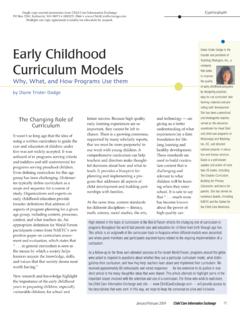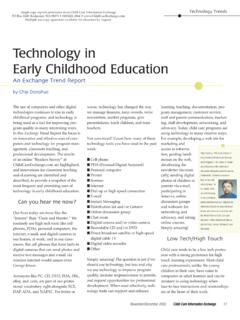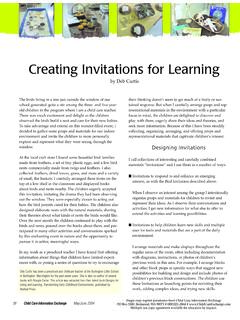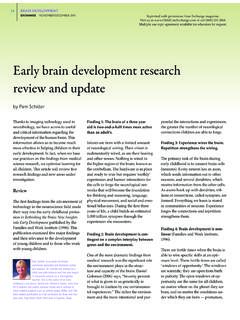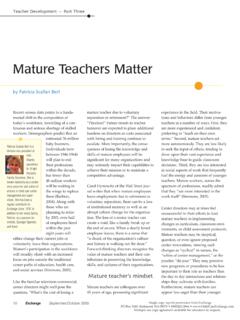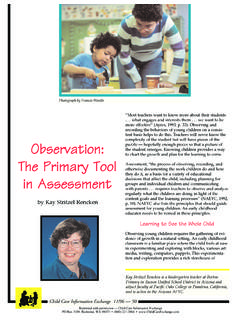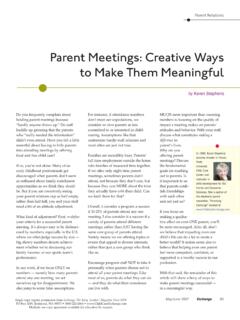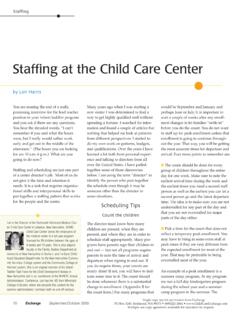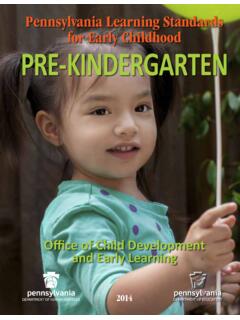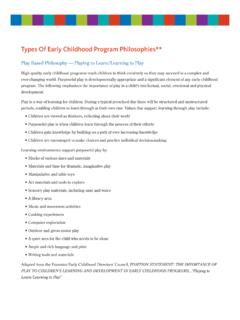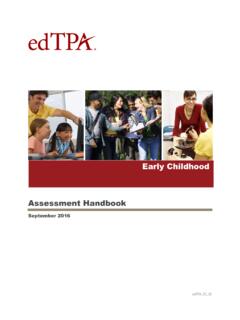Transcription of What Assessment Means to Early Childhood Educators
1 72 ExchangeSeptember/October 2004 Assessmentcific nature of the problem. For example, ascreening tool such as theAges and StagesQuestionnaires (Bricker & Squires, 1999)would be administered to determinewhether there is cause for concern aboutSean s language development. If resultsfrom the screening show a delay, an in-depth Assessment is conducted to deter-mine the specific type of delay, thestrengths and needs of children, and rec-ommendations for intervention. Assessments can also be used to identifyappropriate curricula and teaching strate-gies for individual children and to docu-ment children s progress over time. Forexample, teachers can develop a system-atic plan to document Sakara s progressin attending to a task and to identifywhich teaching strategies help her. Thistype of Assessment is referred to as pro-gram Assessment . Program assessmenttools can also be used for program evalua-tionpurposes when comparing the perfor-mance of groups of children before andafter instruction.
2 For example, teacherscan gather data on children s languageand literacy behaviors at the start of theschool year, before they begin daily pic-ture book reading, and then again at theend of the year. Traditional and alternativeassessments A variety of methods and instrumentsranging from formal to informal observa-What Assessment Means toEarly Childhood Educatorsby Angela Notari Syverson and Angela LosardoTwo-year-old Seandoesn t talk aswell as other chil-dren of his sameage. He communi-cates using ges-tures and a fewone-word phrases,and his articula-tion is difficult tounderstand. Is hislanguage delayed?Does he need spe-cial services?Four-year-oldSakara has diffi-culty payingattention andcompleting a can teachersdo to help her staymore focused?Teachers in thetoddler andpreschool rooms ofa child care centerrecently intro-duced a 15-minute picturebook reading timeinto the dailyschedule. Will theincreased picturebook reading timehave an impact onthe children s language and literacy develop-ment?
3 These are questions Educators mighthave about the children and families intheir programs and about curricula andinstructional strategies they use in theirclassrooms. Observing children andreflecting on educational practices areintegral to high-quality care and educa-tion programs. A sound assessmentsystem can be a useful tool for guidingearly Childhood professionals in thisprocess. What is Assessment andwhy is it important? Assessment can be defined as theprocess of gathering ongoing and com-prehensive information about specificaspects of a child s knowledge, behav-ior, skill level, or personality for the pur-pose of making evaluative decisions(Meisels, 2001). Assessments can be con-ducted for different purposes. Screeningand diagnostic tools were developed tomake identification and placement deci-sions for individual children. Screeningis a brief procedure that determineswhether a child s performance is suffi-ciently different from the performanceof other children of the same chronolog-ical age to warrant more comprehensivetesting.
4 If there is suspicion of a delay,then a diagnostic assessmentprovidesmore in-depth information on the spe-Angela Notari-Syverson is SeniorResearcher at the WashingtonResearch Institute inSeattle where shedirects research,model develop-ment, and staffdevelopment projects in the area ofearly literacy and language assess-ment and intervention. She hasauthored books and journalpublications in these areas and isco-author of Ladders to Literacy, anearly literacy curriculum developedfor use in inclusive education set-tings. Her educational backgroundalso includes degrees in childpsychology and communicationdisorders from the University ofGeneva, Switzerland. Angela Losardo is a professor atAppalachian State University inBoone, NorthCarolina. She hasalmost 30 years ofexperience in lan-guage and literacydisorders and and special Losardo has considerable experi-ence coordinating and conductingresearch projects, personnel prepara-tion programs, and other grant-related projects. She has publishednumerous journal articles, bookchapters, and instructional materialsfor practitioners in the areas of alter-native and cross-cultural assess-ment, Early language and literacy,and personnel preparation ininclusive Early Childhood has co-authored a book onalternative Assessment approacheswith Dr.
5 Angela Single copy reprint permission from ExchangePO Box 3249, Redmond, WA 98073 (800)221-2864 use copy agreement available for Educators by 2004 Exchange73 Assessmenttions are available for professionals touse when assessing children. Assess-ment tools can be grouped into twobroad categories: traditional and alterna-tive approaches toassessment usually involve use of stan-dardized tests for screening and diag-nostic purposes. Standardized tests arenorm-referenced, meaning that a child sperformance is compared to that of anormative group of children of the sameage, gender, geographic location, incomelevel, disability and/or cultural back-ground. Because items on standardizedtests are chosen for their capacity to dis-criminate between groups of children ofdifferent ages, the behaviors tested maynot necessarily be educationally rele-vant. For example, items from standard-ized tests may include asking the childto remove a large round peg from formboard or to point to a pellet in a tests do not yield directinformation for making program deci-sions or choosing curricular content, nordo they provide insight into environ-mental factors and instructional strate-gies that may promote or hinder achild s progress.
6 The results of this typeof test are generally presented as devel-opmental ages, IQs, or percentile approaches to assessmentpro-vide information about what childrenknow and can do rather than on howthey compare to other children. Alterna-tive assessments are the tools of choicefor Educators , because they can be usedto observe children s behaviors in every-day life and classroom activities androutines, as opposed to the highly struc-tured and contrived testing situationtypical of standardized tests. Alternativeapproaches to Assessment take intoaccount the complexity and holisticnature of child development and focuson the interrelationships among devel-opmental domains of behavior. Forexample, a motor impairment in ayoung child may lead to a problem inoral language development, and a prob-lem in oral language development mayput a child at risk for later problemswith literacy. Acomprehensive and holistic view ofchildren can only be obtained if care-givers and teachers collaborate andshare information on an ongoing and Notari-Syverson (2001)describe three approaches to alternativeassessment that a) can easily be inte-grated into and across everyday activi-ties, b) draw from observations andinteractions with children and familiesinvolved in actual tasks and activities,and c) seek to measure children s learn-ing potential by measuring changes inperformance following mediation by models of Assessment includethose in which opportunities to observechildren s behavior are embeddedwithin the natural context.
7 Children areprovided with multiple opportunities toperform skills across domains of devel-opment with different people, usingdifferent materials, in multiple opportunities for childrento perform skills in everyday activitiesis facilitated by use of curriculum-basedassessments. Curriculum-based assess-ments (CBAs) are developmental check-lists or simple tasks used to measure achild s progressive mastery of a curricu-lum. Assessment items are usuallyordered from simple to more complexand organized by developmentaldomains ( , problem-solving, commu-nication, physical, and socio-emotionaldevelopment). Two examples of CBAare theAssessment, Evaluation, and Pro-gramming System (AEPS) for Infants andYoung Children (Bricker, 2002) and theCarolina Curriculum (Johnson-Martin,Attermeier, Hacker, 2004). Performance Assessment and Assessment is abroad term that refers to tasks that givechildren the opportunity to demonstrateand apply their knowledge. Talkingabout pictures in a book, riding a tri-cycle, asking an adult to get a favoritetoy out of the child s reach are examplesof performance tasks where children candemonstrate a variety of language, liter-acy, cognitive, social, and motor completed in real-life contexts( , recognizing one s name on a cubbyhole or climbing playground equip-ment) are referred to as authenticassessment.
8 Portfolio Assessment is a type of perfor-mance Assessment that refers to the pur-poseful collection of a child s workdocumenting the child s effort, progress,or achievement over time. For youngchildren, portfolios may include perfor-mance-based samples such as art anddrawings, photographs of block con-structions, videotapes, developmentalchecklists, anecdotal notes of teacherobservations, and interviews with par-ents. A widely used example of perfor-mance and portfolio Assessment forpreschool children is the Work SamplingSystem (WSS) (Meisels, Jablon, Marsden,Dictelmiller, & Dorfman, 1994). A simi-lar Assessment , the Ounce Scale (Meisels,Marsden, Dombro, Weston, & Jewkes,2003) is available for infants and tod-dlers. Portfolios are powerful tools for facili-tating communication among profes-sionals and caregivers. Parents candocument and share what children cando in familiar and culturally relevantenvironments, such as the home andcommunity, by recording anecdotalnotes, keeping a list of books read withthe child, making telephone calls toteachers, or sending photographs andsamples of children s work to portfolios can include a varietyof media and products, they are usefulto caregivers who do not speak or readEnglish assess-ment acknowledges that both the adultand the child play an active role in theassessment process.
9 Instead of playingthe part of a neutral observer, the exam-74 ExchangeSeptember/October 2004 Assessmentstrategies that work best for individualchildren. Alternative assessments thatare open-ended and allow for adapta-tions and accommodations to make atask more engaging and culturallyrelevant are especially appropriate foruse with children from diverse culturaland linguistic backgrounds andchildren with Families. Achild may displaycompetencies differently in the home,in Early Childhood programs, and othersocial settings. Information from familymembers is critical, especially when thechild s family background differs fromthe mainstream culture and when tradi-tional assessments may underestimatethe child s abilities. ConclusionQuality programs are built upon carefulplanning and purposeful teaching thatresult from making thoughtful, well-informed decisions about what worksbest and what might need to beimproved. Ongoing evaluation andassessment are important parts of thisprocess. Alternative approaches placegreat importance on observations ofyoung children in the context of every-day interactions, the influence of con-text and culture on learning, andinvolvement of families in all aspects ofthe Assessment process.
10 Equally impor-tant is the collaboration among practi-tioners with families in the use ofmultiple sources of information andmethods for , D. (2002). Assessment , Evaluation,and Programming System (2nd edition).Baltimore, MD: Brookes , D., & Squires, J. (1999). Ages andstages questionnaires: A parent completed,child-monitoring system (2nd edition).Baltimore, MD: Brookes , N., Attermeier, S., Hacker,B. (2004). The Carolina , MD: Brookes interacts with the child during test-ing by asking questions and providinginstructional support for the purpose ofdetermining the child s potential forlearning. Dynamic Assessment focuseson the child s responsiveness to instruc-tion which can be measured by compar-ing a child s performance on the sametask before and after the intervention,changes in the types and number ofprompts used, or the amount of adultsupport needed to elicit the the focus is on learning poten-tial rather than what the child alreadyknows, this approach is particularlysuitable for assessing young childrenfrom linguistically and culturallydiverse in assessingyoung childrenEarly Childhood programs are increas-ingly being asked to adopt accountabil-ity approaches that stress results,particularly child outcomes.
